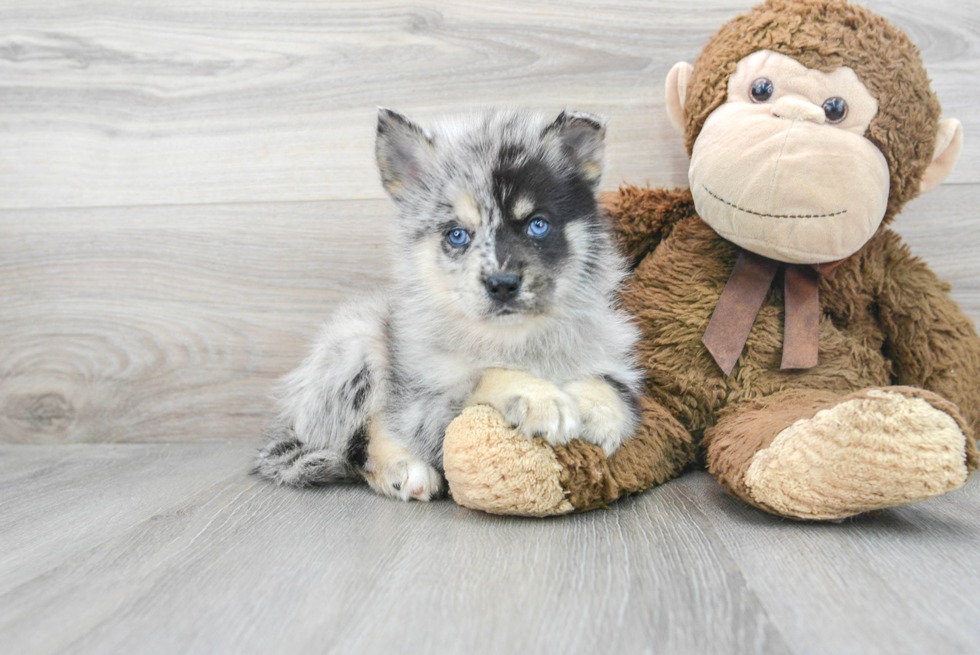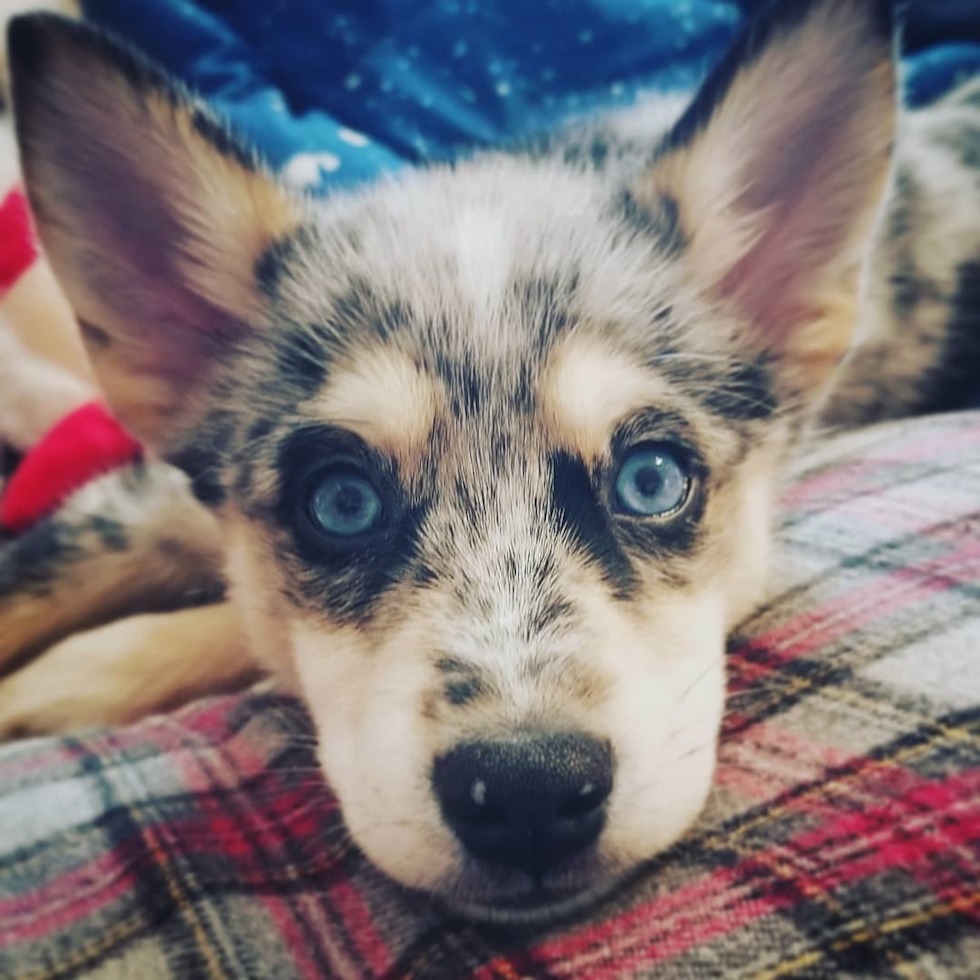
The Pomsky is a stunning mixed breed or designer dog that is achieved by crossing a Pomeranian with a Siberian Husky. Like their parents, that both originate from the Arctic region, Pomskies have a thick, fluffy, and luxurious double coat that protects them from harsh weather. They can withstand pretty cold temperatures but how cold is too cold for a Pomsky?
The cold Arctic weather that is at an average –40 degrees all year round, was never an inconvenience for the Pomeranian ancestors or for the Siberian Husky. The Pomeranian, who is a toy dog, comes for a large sled-pulling Spitz dog from the Arctic. Centuries ago, before the breed was defined into the lapdog we know and love today, the Pom was a big dog that worked in the snow for a living.
Things are a bit different now given that Pomeranian dogs went through generations of change. Their coats are not as thick nor as insulating as they once were for the Spitz dogs. Huskies on the other hand, despite moving to warmer climates, still retain their perfectly insulating fur coats.
Table of Contents
How Cold is Too Cold for Dogs in general?

Below 32 degrees Fahrenheit is usually too cold for most dog breeds and temperatures below 20 degrees pose high risks for hypothermia and frost bite. All dogs handle cold weather differently. Some are comfortable rolling around in the snow during freezing weather, while others shiver during chilly summer nights. How active they are, what they are fed, if they are always kept outdoors or inside, or what type of fur they have, all play an important role in determining how cold is too cold for them.
Their size and weight are also a key factor to consider. The Chihuahua for example, is a tiny, toy dog that has a very short coat and a very thin build. Chihuahuas can’t stand any type of freezing weather. Bernese Mountain dogs on the other hand, are large dogs that have a fluffy double coat that provides the perfect insulation for freezing weather. Simply put, toy dog breeds with short coats don’t usually take well to cold temperatures.
Another key factor that can help you understand how cold is too cold for your dog is the seasonal coat changes. A dog that lives outdoors all year round will most likely develop a very thick coat during the winter season. For an outdoor dog, wintry weather is just as comfortable as sunny weather. A dog that lives indoors will develop a thicker coat during the cold season, but not as thick or as protective/insulating as the dog that lives outside.
How Cold is Too Cold for a Pomsky depends on:
Where you raise a Pomsky puppy
Dogs adapt well to any type of weather as long as they are raised in the same climate for their entire lives. So, if you live in Alaska, and you’ve raised your Pomsky puppy there since early puppyhood, your dog will be comfortable in any type of Alaskan weather. As we mentioned before, the Pomeranian puppy and Siberian Husky both come from Arctic ancestors.
They have double coats that help keep them protected from harsh weather. If you’ve lived and raised your Pomsky puppy in Florida for two years and are considering moving to a colder climate, your dog will need some time to get adjusted to new temperatures. In this case, your Pomsky will adjust to its colder surrounding environment in a few seasons.
Its coat will change to a thicker texture that will become more insulating over time. Keep in mind that the Pomsky is a small dog breed that should not be kept outside at night, especially during winter. Leaving a Pomsky outside during freezing weather can cause the dog to suffer from hypothermia.
What type of Pomsky you have
Pomskies are small to medium sized dogs. They are sometimes bred through multiple generations to achieve a smaller size or certain physical characteristics. Their breed generation is their genetic make-up. They can be more Pomeranian than Husky in their genes or half and half. In some cases, they can be more Husky than Pomeranian when it comes to their genetic make-up. For example:
- An F1 Pomsky puppy that is a first-generation mix, is 50% Pomeranian and 50% Siberian Husky. This puppy can inherit looks and coat qualities from both parents. An F1 Pomsky puppy is much like the Siberian Husky when it comes to cold temperatures. It has a thick, double-layered coat that provides ideal insulation for wintry weather.
- An F1b Pomsky puppy that is a first-generation backcross, is 25% Siberian Husky and 75% Pomeranian. This puppy takes after the Pomeranian in most aspects. It has some gorgeous Husky features like coat patterns and colors, but it inherits the Pomeranian size and coat thickness. The F1b Pomsky is not as winter-friendly as the F1, but it does like the snow nonetheless.
How Cold is Too Cold for a Pomsky: Conclusion
Pomskies are cold-friendly dogs that love winter and snow with a passion. They adore playing in snow and taking part in any winter activity they can. And thanks to their thick, double coats, cold weather isn’t an issue for them. That being said, a Pomsky adult should not spend more than a few hours playing in weather below 32 degrees. They might be comfortable in weather below 32 degrees but only if they are active while outdoors and only for a limited time.
Scroll down to see FAQs about Pomskies in cold and hot weather!
What To Read Next
What is the Difference between F1, F1B and F2 Mixed Breed Generations?
5 Fun Christmas Activities Your Dog Will Love
Frequently Asked Questions
What is a Pomsky? A Pomsky is a designer breed dog that is a cross between a Pomeranian and a Siberian Husky. They are known for their cute and fluffy appearance, as well as their friendly and playful personality.
How cold is too cold for a Pomsky? Pomskies are a small breed of dog with a thick coat, which makes them well-suited for colder climates. However, as a general rule, temperatures below 20 degrees Fahrenheit (-6 degrees Celsius) can be dangerous for Pomskies, especially if they are outside for an extended period.
What are the signs of hypothermia in a Pomsky? Hypothermia is a serious condition that can occur when a dog's body temperature drops below normal levels. Signs of hypothermia in a Pomsky may include shivering, lethargy, pale gums, and a decreased heart rate. In severe cases, hypothermia can lead to coma or death.
How can I keep my Pomsky warm in cold weather? To keep your Pomsky warm in cold weather, you should provide them with a warm and comfortable shelter, such as a heated dog house or a cozy blanket. You can also invest in warm dog clothing and boots, and limit their time outside in extreme cold weather.
Can Pomskies live in warmer climates? While Pomskies are well-suited for colder climates, they can still live comfortably in warmer climates if they are provided with appropriate care. It's important to keep them cool and hydrated, limit their time outside during the hottest parts of the day, and provide them with access to shade and cool water.
Are Pomskies good with children? Pomskies are generally good with children, as they are friendly and playful dogs. However, as with any breed, it's important to supervise interactions between children and dogs to prevent any accidents or injuries.
How much exercise does a Pomsky need? Pomskies are a moderately active breed that requires daily exercise to stay healthy and happy. They enjoy walks, runs, and playtime with their owners, and should be provided with at least 30 minutes of exercise per day.
Do Pomskies shed a lot? Pomskies have a thick double coat that sheds seasonally, typically in the spring and fall. During shedding season, they will require more frequent brushing and grooming to keep their coat healthy and free of tangles. Outside of shedding season, Pomskies are considered a moderate shedding breed.




